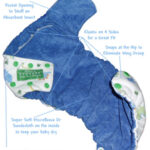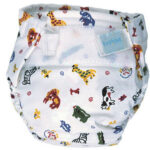Many mothers find themselves plagued with low milk supply. Unfortunately for some of them, this becomes so discouraging that it effectively signals the beginning of the end of the breastfeeding relationship. But low milk supply does not have to spell doom for a breastfeeding mother and child.
Diagnosing low milk supply
Many mothers think they have a low milk supply when in reality there is nothing wrong with their supply. So what are some of the signs that you may have a low milk supply?
— Baby does not wet at least 6 diapers a day. “Wet diaper” means approximately three tablespoons of liquid. Pour three tablespoons of water into a clean, dry diaper to see what that feels like. As long as baby is hydrated, you can rest assured that she is getting enough to eat, which means that you do not have a low milk supply.
— You cannot hear baby swallowing while nursing. You may have to listen very closely to hear her swallowing. If she sucks and sucks without swallowing, she is not getting milk and you may have a low milk supply.
— You cannot feel your milk let down while nursing. Not all mothers can feel when their milk lets down. But if you can, that’s usually a good sign that you are producing milk and do not have a low milk supply.
— You cannot see milk at the corner of baby’s mouth while nursing. Babies are messy eaters, and they almost always will get some milk at the corners of their mouths while they nurse. If you can see that, then she is getting milk.
— Baby is not gaining weight steadily. The most effective way to tell if your baby is getting enough milk is to monitor her weight gain. On average, a baby should gain between one and two ounces per week, but this can vary. Talk to your child’s doctor about her weight gain. If there is any cause for concern, you can work from there.
Eat your oatmeal
Oatmeal has been shown to stimulate milk production, so it’s one of the best things you can eat to increase a low milk supply. For best results, use the old-fashioned oats instead of instant oatmeal. Instant oatmeal is processed differently and won’t work as well to boost a low milk supply.
Everyone should drink at least eight to ten cups of water per day. This is especially true for nursing moms. Dehydration is a major cause of low milk supply. While there is no need to get completely water-logged, shoot for around three quarts of water per day while trying to boost your supply, and at least two quarts a day the rest of the time.
Get plenty of rest
I know – easier said than done when you have a baby in the house. But overexertion can lead to low milk supply. Your body will not have the energy to produce milk if it is focusing too much on simply staying awake. Try to nap when baby naps – at the very least, lie down with your feet up. Get as much sleep as possible at night. Enlist the help of your partner, family, and friends to watch baby while you get a few extra winks in the morning, or steal a quick catnap in the afternoon.
Many moms have found it helpful to take a “baby vacation” for a day or two. This involves staying in bed, keeping baby in bed next to you, nursing and sleeping frequently. Having baby so close by for such a long time is often all that is needed to boost a low milk supply.
Again, this can be difficult with a baby in the house. Emotional stress can play havoc with many of our bodily functions, and milk production is no exception. Too much stress can cause low milk supply rather quickly. Try to take some time each day to “de-stress”: take a warm shower or bubble bath, read a book, watch your favorite sitcom. Do whatever relaxes you.
Nurse frequently
When the breasts are stimulated, the body will be prompted to produce more milk. When the breasts are emptied, a signal is sent to the body that the baby needs more milk. It’s a basic function of demand and supply: if baby doesn’t drink the milk, then the body won’t replace the milk, which can result in low milk supply.
Pump between feedings
For extremely low milk supply, the breasts may need a little more stimulation than baby is willing to provide. In these instances, a breast pump can be very useful. Pump for five to ten minutes between feedings, or before the start of each feeding. Be careful not to pump too much, or you may end up with an oversupply issue, which is uncomfortable for you and not all that good for baby.
Herbal supplements and medications
Most mothers are able to boost a low milk supply by the other methods already mentioned, but occasionally a mom will need a little extra help. For these moms, there are a variety of herbs and medications available. Fenugreek and blessed thistle are the two most common herbal supplements that women use to boost milk production. These are readily available at most health food stores and vitamin shops.
Metoclopramide and domperidone are two common prescription medications available for increasing a low milk supply. These are only available through your doctor, and you should discuss the risks and benefits of these and any medications before taking them.
Many of the herbs and medications used to boost milk supply have been linked to digestive problems. If you or your baby has a history of digestive issues, it may be best to forego any kind of supplement and stick to the other methods outlined here for boosting milk supply.
These are tried-and-true methods of increasing milk supply. Give them a try. For more information about low milk supply, please refer to the links at the end of this article.
**This is one of a series of articles about common breastfeeding problems. To see the rest of the series and other articles by this writer, please click on the picture of the baby’s bottom, at the top of the article beside the author’s name. **






